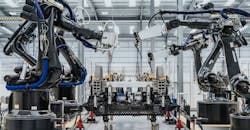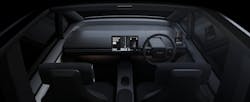Arrival EV Progressing With Strategic Partnerships
Since coming out of stealth mode with commitments and investments from UPS, Hyundai and Kia, electric vehicle (EV) manufacturer Arrival has been steadily making progress towards releasing its first batch of vehicles, focused on fulfilling opportunities within the commercial transportation sector.
Today, the firm with headquarters in London and Charlotte, NC, is on track to start delivering vans, buses and now cars.
Arrival entered the scene leveraging a unique approach to manufacturing. Specifically, the company is utilizing a microfactory approach with two facilities underway in the U.S., including a bus facility in Rock Hill, SC, as well as a van facility in Charlotte, NC.
Assisted driving update
Arrival recently announced its selection of the Santa Clara, California-based Ambarella’s CV2FS AI vision processor for the environmental perception module available for all types of Arrival vehicles. The module will be used to enable autonomous driving (AD) and ADAS features in both the bus and van.
The Ambarella CV2FS AI vision processor offers an open platform for differentiated, high-performance automotive systems and is designed to enable safety-critical applications. With CVflow AI processing and ASIL-B(D) compliance, CV2FS targets forward-facing monocular and stereo vision ADAS cameras, as well as computer vision ECUs for high levels of autonomy.
The selection of an ADAS partner is a crucial step for Arrival, Sergey Malygin, EVP of Technology at Arrival. “We see huge opportunities for autonomous driving to positively transform how we get around. This is why we have made the upfront investment to future-proof our vehicles so they can support autonomous functionality,” Malygin tells IndustryWeek.
Senya Pertsel, a senior director at Ambarella tells IndustryWeek, Arrival cited the AI performance, image quality, support for stereovision and the low power consumption of Ambarella’s solutions which spread across a family of edge AI vision SoC (system on a chip) offerings. “We offer the best AI vision SoC performance per watt and have extensive experience working with customers on their AI vision designs, with 175 paying customers in evaluation and 40+ in mass production,” says Pertsel. “We provide the same software development kit and tools for our entire portfolio, which lowers the learning curve and speeds their time to market, while enabling them to leverage our SoC portfolio to create a common technology platform across their product lines.”
The ADAS features will provide commercial sector vehicles with advanced safety and convenience-related driver assistance capabilities, including lane departure warning (LDW), lane keeping assist (LKA), vehicle, pedestrian and cyclist detection, blind spot monitoring (BSM), traffic sign recognition (TSR) and traffic light recognition (TLR). All of these capabilities are of paramount importance where commercial vehicles are operating in busy urban environments and driving a significantly higher mileage than consumer cars, enabling them to operate as safely and efficiently as possible, while enabling progressive levels of autonomy without the need for hardware updates.
Of course, autonomous driving is a very complex and challenging problem to tackle. A problem “that will require patience and partnerships across the industry,” says Malygin. “Our approach is to take incremental steps as we develop and integrate the technology. We don’t have a set timeline for AV development and right now, we’re focused on ensuring that it is safe and works alongside drivers and other workers.”
Within the autonomous driving/ADAS space, one of the challenges is the need for increased AI performance, while at the same time keeping power consumption within a certain level. “Ambarella SoCs help here by offering a high-performance, yet power-efficient, AI engine. Other challenges include meeting the high functional-safety standards required by ADAS applications and delivering good camera perception in challenging lighting conditions, which is where the image signal processing technology in Ambarella’s SoCs comes into play,” says Pertsel. “To date, Ambarella has invested more than $500 million into our AI vision SoC development, and we are continuing to heavily invest. In the automotive arena, we will continue to evolve our offerings to address customers’ needs as they move up the levels of autonomy.”
Arrival is also partnering with Uber who has committed to embracing a fully electric mobility platform in the UK by 2025 and across North America and Europe by 2030. The goal is to develop a car for ride-hailing drivers with production starting in Q3 2023.
“The Arrival Car will be designed to be an affordable, purpose-built electric vehicle for ride-hailing, and will be designed in partnership with Uber drivers,” says Malygin. “Uber drivers are being invited to join the design process and ensure the final vehicle meets their needs, and we are currently exploring a strategic relationship with Uber in key markets, including the UK and EU.”
“We are confident that electrifying ride-hailing vehicles will have an outsized impact on cities, and we are keen to support drivers as they manage this transition,” says Tom Elvidge, senior vice president of Arrival Mobility UK, in a statement. “We have a great partnership with UPS to create a best-in-class electric delivery vehicle, and we hope to replicate that success with Uber as we develop the best possible product for ride hailing that elevates the experience of the passenger and improves drivers’ health, safety and finances.”
About the Author
Peter Fretty
Technology Editor
As a highly experienced journalist, Peter Fretty regularly covers advances in manufacturing, information technology, and software. He has written thousands of feature articles, cover stories, and white papers for an assortment of trade journals, business publications, and consumer magazines.


